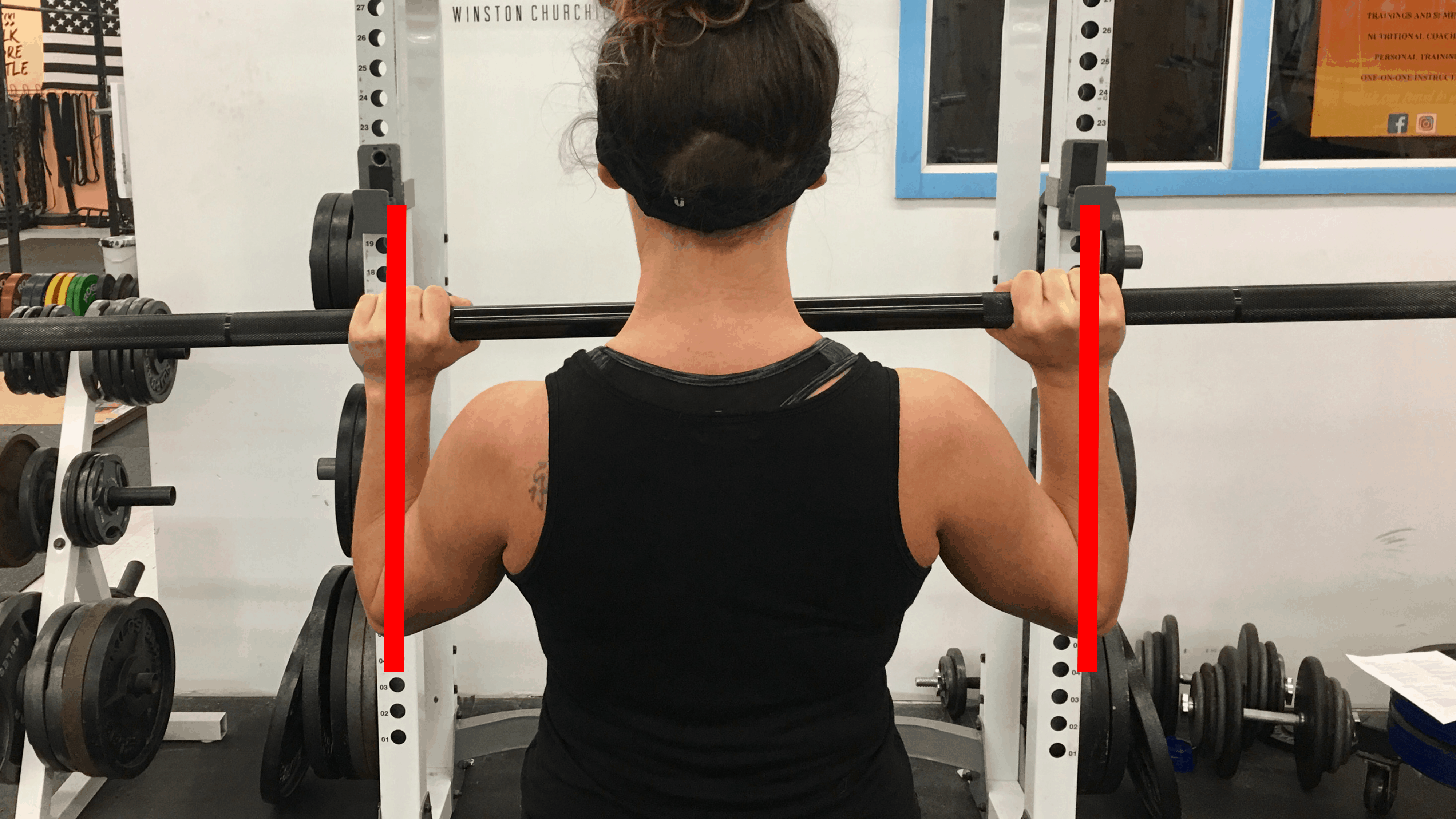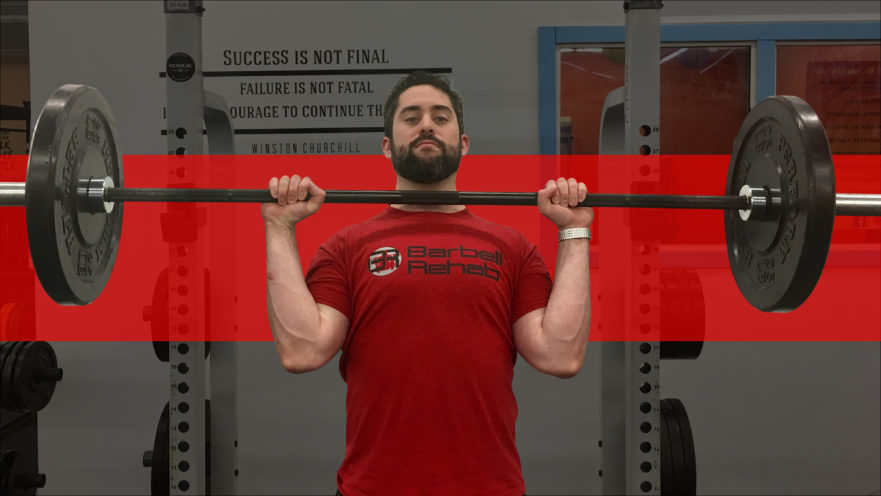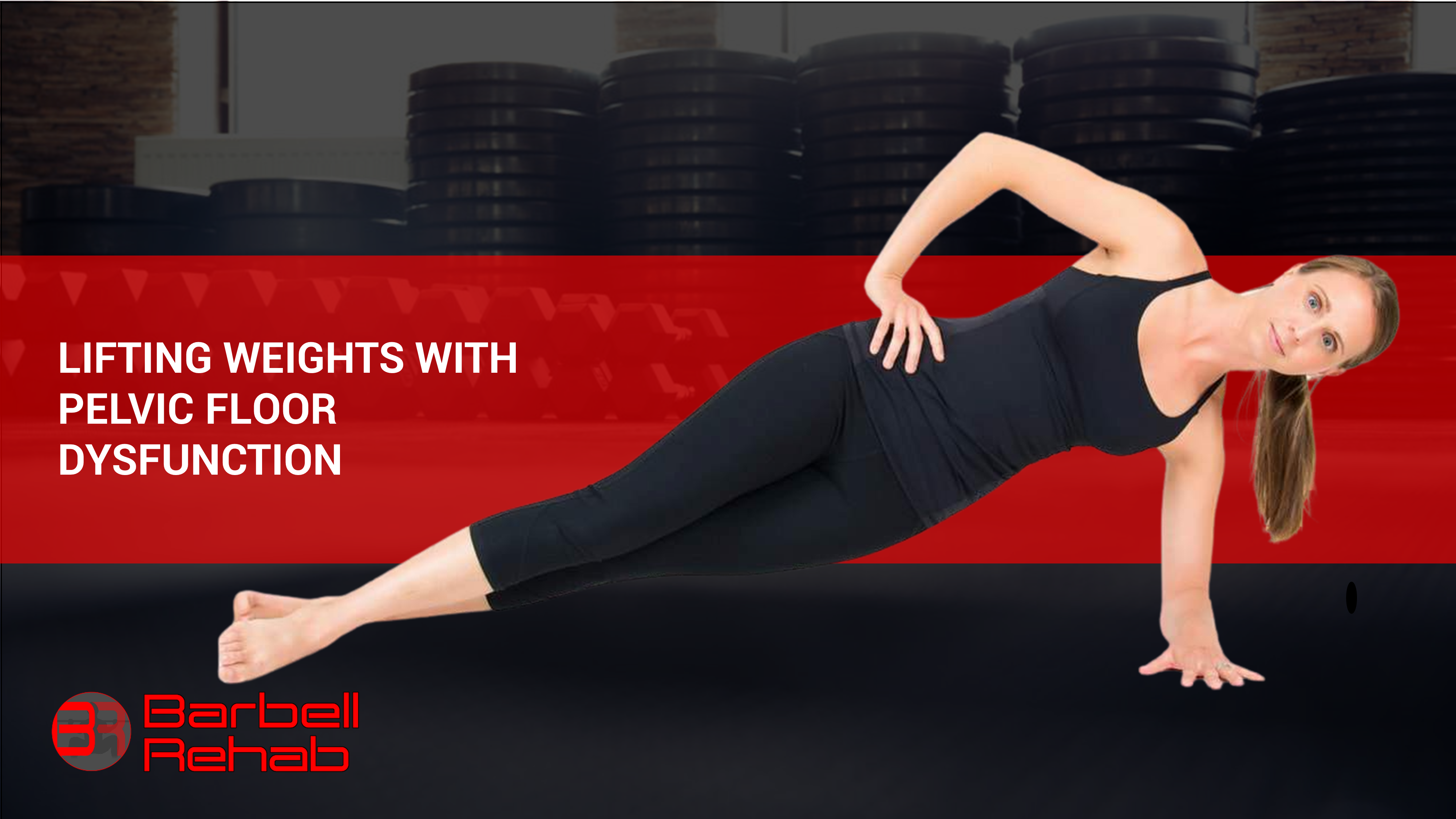The overhead press is one of the most powerful shoulder strengthening exercises we have at our disposable. Unfortunately, sometimes it may not feel the best on the shoulder. If you are dealing with shoulder pain with the overhead press, listen up! I’ll show you exactly how to overcome it.
Do You Have the Shoulder Mobility to Overhead Press?
First thing’s first. In order to achieve an optimal lockout position on the overhead press, you need to possess an adequate amount of shoulder mobility to do so. You don’t want to perform and strengthen through a movement if you can’t even get there actively in the first place.
In order to barbell overhead press, you need to make sure you have:
- Full shoulder flexion
- Scapular upward rotation
- Decent thoracic extension
So if you’re dealing with shoulder pain with the overhead press, the first thing I would check is to make sure you actually have the mobility to do this exercise.
A Quick Way to Check Overhead Shoulder Mobility
To assess your shoulder mobility, lie on your back, bend your legs, and flatten out your spine. Grab a stick with the same grip width you’d use on the overhead press, and then see if you can take it all the way overhead without pain.

If you can, congratulations! You have the mobility, or the ABILITY, to actually get to the overhead lockout position. So if you’re having shoulder pain with the overhead press and you can get into this position, you can probably rule out mobility concerns.
If, on the other hand, you can’t get into this position, I’d recommend performing mobility drills in order to restore it, prior to loading the heck out of a barbell overhead press. Here are some examples for you.
Shoulder Mobility Drills for the Overhead Press
With the supine wand flexion exercise, the assessment actually becomes the prescription. If you’re having trouble getting overhead, you basically just want to start spending more time there.
For this drill, you can slide a 5lb weight onto the stick, then slowly take it overhead and hold it at the top. Make sure you’re breathing normally. This also shouldn’t be painful. It should just feel like a stretch. Hold this for 10-15 seconds and perform 3-4 sets daily.
Another great drill to help restore end range shoulder flexion is the foam roller wall slide. Since you’re standing up for this one, you will also get the benefit of mobilizing into thoracic extension as well.
To perform this optimally, once the foam roller passes your head, work on pushing your torso and head under the roller to encourage end range shoulder flexion. For this, I’d recommend performing higher reps with less hold time. 10-15 reps with a 5 second hold works well for this.
Wall sit backs are a nice alternative to the foam roller wall slide. These also will help you restore end range shoulder flexion and thoracic extension as well. To perform, stand with your hands on a wall, and then push your butt backwards until a stretch is felt in your shoulders and upper back.
If you are experiencing shoulder pain with the overhead press, and also determined that you have a shoulder mobility limitation, give some of these drills a try.
How to Strengthen With Shoulder Mobility Limitations
If you’ve determined that you have a shoulder flexion mobility limitation, you can't solely perform mobility work. In general, you should never just perform mobility exercises, as this can lead to detraining of the affected body part and decreased tissue tolerance.
If you’re going to remember anything from this article remember this:
Strengthen within the range of motion you have, and mobilize into the ranges of motion you want.
The Landmine Press: The Best of Both Worlds
The landmine press is a perfect overhead pressing variation that you can perform while you’re simultaneously working on restoring end-range shoulder flexion.
By adjusting the torso angle of the landmine press, you can actually achieve more and more shoulder flexion as you slowly gain the mobility for it.
Once your shoulder flexion mobility is restored, you can then move to the standard overhead pressing variations with barbells and dumbbells
What if It’s Not a Shoulder Mobility Issue?
So what if you determined that you don’t have a mobility issue, but you’re still experiencing shoulder pain with the overhead press?
The first thing I would do, is to actually make sure you're performing the lift optimally. Check out our barbell overhead press tutorial for this!
The next step I would take is to change some modifiable factors about the lift itself to see if you can make it more tolerable.
Optimize and Adjust Grip Width on the Overhead Press
Grip width is of the most powerful factors you can adjust on the overhead press in order to radically change your pain experience. Ideally, you want to take a grip width that will create vertical forearms from the back view. This will allow maximal force transfer to occur through your forearms and wrists in to the bar.

If you weren’t doing this already…try it! If you were already doing this and are still dealing with pain with the overhead press, then try moving the grip in or out some to see if this helps. The idea is to see if you can find a grip width that will feel more tolerable for you.
Adjusting the Load and Dosage
I feel like I include this paragraph in every how to overcome pain article I write, but rightly so. No amount of form modification will help if you’re applying a less-than-optimal dosage!
In general, for the overhead press or any major barbell lift for that matter, you want to make sure you’re not performing too much volume above an RPE 8.5 or 85% 1RM.
If you’re only having shoulder pain with the overhead press at higher intensities, reducing the load a bit and working on building up your tolerance again to the movement can be a simple solution
Try the Dumbbell Overhead Press Next
If you’re still having shoulder pain with the overhead press even after adjusting the dosage and modifying the grip width, the next thing I would try is a dumbbell overhead press.
Performing a dumbbell overhead press gives you more freedom to select the ideal “arm slot” or degree of shoulder horizontal abduction/adduction that will feel best to you!
Sometimes it feels good to press with the dumbbells directly in front of you (flexion). Other times it may feel better to press with them out to the side (abduction). Most commonly, it feels best to press with them somewhere in the middle, in the plane of scaption. Take a look at the video below to see what I mean.
When All Else Fails…Remove the Aggravating Motion
Sometimes no amount of load or form modification will help reduce your pain. In cases like this, the overhead pressing patter itself is so sensitized that you may need to completely remove it from your program all together.
I typically see this situation in people that have experienced an acute shoulder injury. Remember, you should NOT be consistently overhead pressing through pain.
If this is the case, or if it just hurts to simply reach your arm overhead, temporarily remove this motion all together, and seek out an evaluation from a physiotherapist who knows about lifting weights. Once the overhead motion itself is tolerable again, you can start to dose it back in.
Don’t Forget About the Accessory Work
While you can modify around pain all you want, you want to also make sure you’re tackling weakness directly too. If you’re dealing with shoulder pain with the overhead press, you want to make sure you’re performing a balanced program that includes some of the following
- Horizontal Row Variation (DB/Cable Rows)
- Vertical Pulling Variation (Lat Pulldowns/Chin Ups)
- Scapular Retraction Work (Rear delt flies / band pull aparts)
- Rotator Cuff Specific Work (Sidelying ER / Face Pulls)
A sample upper body day workout for someone experiencing shoulder pain with the overhead press may look like this:
- Standing DB Press 3 x 8
- Alternating DB Bench Press 3 x 6 / side
- Cable Row 3 x 12
- Lat Pulldown 3 x 12
- Rear Delt Fly 3 x 12
- Sidelying ER 3 x 12
Overall, however, the assistance work should be tailored to your individual needs and limitations.
Tying it All Together
Experiencing shoulder pain with the overhead press can be a frustrating experience, but it doesn’t have to be a permanent one. If you’re dealing with this, here’s what I’d do:
- First, make sure you have the mobility to perform the overhead press. If you don’t, work on mobility, and landmine press until it’s restored
- If you have the mobility and are still having pain, try and adjust the load, programming, or grip width to see if you can make it more tolerable.
- If adjusting the modifiable factors doesn’t work, try a dumbbell overhead press instead. See if you can find an “arm slot” that feels comfortable for you.
- If the overhead motion itself is so sensitized, you may need to completely remove it temporarily in order to get it to calm down.
- Make sure you’re performing a balanced program consistently of scapular retraction, vertical and horizontal pulling, and rotator cuff specific drills too.
Follow the plan above to finally overcome shoulder pain with the overhead press!





